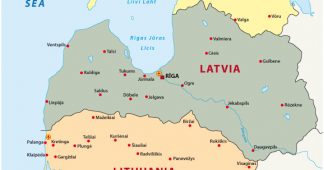by David Grant
October 13, 2019
Data from the United Nations Population Prospects has reiterated previous fears of a longstanding shrinking in the population of eastern, south-eastern and central Europe. Forecasts suggest the top-ten fastest shrinking countries are all from Eastern/Central Europe, of which seven of these states are EU members. This article seeks to explain the drivers behind such a phenomenon, outlines attempts some governments are making to prevent such emigration and what is anticipated for these states looking forward.
Bulgaria sits top of the pile when it comes to population shrinkage, losing citizens at a faster rate than anywhere else on Earth. One million Bulgarians have departed their homeland since the fall of the Soviet Union, predominantly to other EU member states; the UN projects this to continue for many years to come, its population will fall from 7.2 million to 5.2 by 2050, a rate of 23% over the next thirty years. But this problem is replicated elsewhere in the region, from the Northern Baltic states, where Lithuania has seen a 23% population decline since 1990, to the Balkans. In 2018, the Croatian President sighted the EU, and its key tenet of the freedom of movement to account for the 230,000 people who left Croatia between 2013-2016. Currently, Bulgaria and Lithuania vie for the unenviable crown of the fastest shrinking country. Between 1991-2015, the Baltic States and Bulgaria lost between 16% and 26% of their populations.
The reasons for this exodus are numerous and multifaceted and vary for each individual country. However, there are underlying trends which can offer macro-level explanations for this decline: a combination of extremely low birth rates, mass emigration and high mortality figures, combined with access to free movement have contributed towards such large scale depopulation.
What is causing this regional population decline?
Many of the states in question spent several years under Soviet-era emigration controls, strictly prohibiting large scale outflows of citizens. Population decline has been brought about by two key geopolitical events: the collapse of the Soviet Union and the enlargement of the European Union. These events allowed for greater movement of citizens amongst former Soviet states. Additionally, entry into the European Union, which permits for free movement of people has actively encouraged many citizens to look for opportunities elsewhere.
Latvia is emblematic of this trend. Since accession to the European Union in May 2004, it has lost one-fifth of its population. Latvia’s population has steadily decreased from a peak of 2.66 million at the end of Soviet rule, to 2.38m in 2000. Now it has dipped below 2 million. This is a scene replicated in neighbouring Lithuania, which has one of the world’s fastest declining working-age populations.
Paradoxically, many of the countries most afflicted by depopulation problems are also those most opposed to policies increasing immigration. This is problematic because increased inward flows of immigrants are seen as a key ameliorating factor, and also one of the economically simplest fixes. However, politically, plugging such demographic shortfalls with immigrants can be a tough sell. Visegrad governments in central Europe, namely in Hungary and Poland are loath to accept immigrants.
The latter has even risked infringement proceedings by the European Commission to achieve these aims. The “Stop Soros” legislation proposed by the Hungarian government led to critical comments from Felipe González Morales, the UN special rapporteur on human rights. These nationalistic tendencies are keeping migrant flows from areas which are most at the need of new arrivals to rejuvenate local labour markets. Hungary and the Czech Republic rank more negatively than other Europeans when it comes to immigration, but they remain at imminent danger, with their working-age populations anticipated to fall by 4% and 5% between 2015-2020.
Economic stagnation
Economic stagnation is part of the story of mass emigration from Eastern Europe. In Bulgaria, the demographic decline is most pronounced in the rural areas, particularly in the north-west, which is the poorest region of the poorest country in the EU. The average salary in Bulgaria is €575 a month, and the average monthly pension is €190, both of these are the lowest in the European Union. Similarly, Latvia’s poorest region, Latgale, sees the greatest population shortfall. Here the average monthly wage is only €670 a month. The respective capitals, Sofia and Riga are slowly growing but rural populations are continually decimated. Lower wages, combined with better living standards elsewhere, drive labour westwards towards Germany, France and the U.K. as people seek better opportunities for themselves and their families. Often they go to live with family members already settled further west making such a transition easier.
Low birth rates are a hallmark of numerous European countries, but many of the former Soviet states lack the tools to correct the problems arising from population decline. Birth rates in eastern Europe sharply dropped in the 1990s during the post-Soviet era of political and economic upheaval. Because of this, Lithuania is suffering a lingering shortage of working-age adults in its workforce. Consequently, the number of 18 year-olds has collapsed by 33% since 2011. UN predictions believe Lithuania will have the same number of working-age adults in 2030 as it did in 1950. Meanwhile, population shrinkage has been blamed as a causal factor in increased mortality, due to the ‘brain-drain’ effect. Romania lost half of its qualified doctors between 2009-2015 who sought better wages further west. This has been attributed to both higher mortality and infant mortality rates in the country. For the population to remain constant, women need to have 2.1 children, however, in numerous eastern European states, the level is far lower, hovering between 1.5-1.7. Low Immigration, combined with low fecundity and higher mortality rates make for the perfect cocktail of population shrinkage.
Apart from the causing ruptures in the social fabric of the state, population decline is causing numerous harmful economic consequences which are tricky to fully mitigate. Emigrants tend to be younger, first time workers in seek of better wages. They also leave with their children or before childbirth, meaning the median population age increases, and the adult population of a working-age diminishes.
Fewer working-age citizens
In some parts of the world, the working-age (25-64-year-old) demographic is growing faster than other groups, offering the beneficiaries the chance of rapid economic growth, known as the “demographic dividend.” The stagnation in births, especially during the 1990s and mass exodus seen in Eastern Europe and the Visegrad states has already contributed towards a dwindling of a number of new entrants into the job market. Increasingly the number of people of working age has already declined and will continue to do so.
These problems are often seen in economically advanced states. Japan is an oft utilised example for a nation grappling with a population-weighted towards older inhabitants and demise in working-age adults. But eastern European states such as Bulgaria (which is Europe’s fifth greyest (oldest) country) are facing the same problem despite their relative economic weaknesses. Politically they cannot increase immigration and instead seek to attract the Bulgarian diaspora from neighbouring countries. Fiscally the effects can be severe.
Fewer people means fewer mortgages on houses and fewer people requiring bank accounts and credit. These demographic trends of fewer available workers lead analysts to predict a drag on the growth of 0.5-1% per year over the next 15-20 years. Fewer workers mean diminished productivity, reduced public spending on public goods and the brunt of future national debt falls on even fewer contributors, making for a distorted economy. Caring for the elderly, who live longer than their predecessors is also a responsibility the state will have to burden. In central Europe, the working-age population of the four Visegrad states will fall by 12 percent by 2040, twice as fast as the EU average, vastly outpacing the levels seen in western Europe.
A key benefit to this sequence is healthy employment figures witnessed in much eastern Europe. Unemployment rates in Hungary and Bulgaria sit at historical lows of 3.4% and 4.4% respectively. The low supply of workers has facilitated unprecedented wage growth, as companies fight for the bare pool of available workers. This is an east versus west divide across Europe: Britain, France and Germany have seen wages stagnate in the decade since the 2008 Financial Crisis. Eastern Europe bucks the trend in showing persistent growth in both nominal and real terms. Nominal wage growth currently sits at 6.6% across the region. However, it is not all good news for workers, as this wage growth has culminated in generalised inflation, Latvia and Hungary both experience inflation rates of over 3%. This is significant because these wage gains have diminished the nominal value.
Reinvigorating birth rates
Weaning governments off aforementioned fears over immigration is the first hurdle in counteracting the general trend of population decline seen in eastern Europe and the Visegrad states. Bulgaria’s birth rate is almost exactly equivalent to Germany’s but suffers inexorably greater problems from population decline. The difference is that Germany is accepting more migrants, subsequently, its working-age population is shrinking at a much slower rate. Here, Estonia and Poland offer guidance on how to utilise immigration as a force against population decline.
Poland has relied on a steady inflow of Ukrainians into its workforce, meaning they now form two-million of the sixteen-million workforce. Estonia, which saw 17% of its population depart after the collapse of the Soviet Union has recently slowed the rate of net population decline, far outperforming its Baltic counterparts. However, immigration is not the only tool in the box to arrest such population shrinkage. Even a million new migrants in Germany may be insufficient to prevent Germany’s future demographic problems.
A way to improve the working-age population would be to get more women into paid work, where their participation in the labour market is significantly less than men. The key issue is that more women working tends to correlate with a collapse in the birth rate. Ideally, governments in eastern Europe want increased birth rates and numbers of working adults, but often these policies juxtapose each other. In Poland, the Law and Justice Party successfully campaigned with a flagship “500+” child benefit law which came into effect in 2015. It offered women $130 a month for every second and subsequent child but also offered state assistance for childcare and schoolchildren.
Whilst this was enacted to improve the overall birth rate it has been criticised as a means to discourage women from working. Viktor Orban has followed Poland’s lead in offering similar packages to invigorate the birth rate. Hungary has witnessed its own population depleted by 500,000 since the turn of the millennium. In the spring of 2019, the ruling Fidesz Party announced its plans to offer cash incentives for women who have more children and subsidies on family cars. Orban went even further by offering lifetime exemptions from income tax for women who bear four or more children. However, increased female participation in the labour market and an increased birth rate are not mutually exclusive. Governments offering more progressive maternity/paternity laws and employers becoming more flexible could see both of these categories expand. Nevertheless, companies suffering from labour shortages in eastern Europe and therefore a lack of capacity have found adopting such policies extremely tricky.
Looking forward
Anticipating and measuring population decline is an unenviable task. However, it appears more of a regional phenomenon than a state-level occurrence. Eastern and south-eastern Europe seem to be experiencing population decline, in the same manner, Africa’s is booming. Countries with shrinking populations are often surrounded by others suffering the same quandaries. Mass emigration and population decline, assisted by the end of the Cold War and latterly facilitated by accession into the EU by many former Soviet states, has been occurring since the early 1990s so it isn’t a new phenomenon.
However, states do appear to be grappling with these key policy issues. The U.N. has claimed demographic experts foresee a population drop in Poland of nearly 40% by 2100, but its government is ameliorating this decline by actively bringing in foreign workers from Ukraine to replenish its population and workforce. A chaotic no-deal Brexit may even see more Poles emigres return from the U.K. Similarly, Estonia has slowed the rate of its own population decline. Elsewhere in the Baltics, there are tentatively promising signs, with the Central Statistical Bureau of Latvia noticing a small increase in the number of Latvian emigres returning to their homeland.
However, the status quo seems a widescale expectation of sharp declines in the populations of eastern and south-eastern Europe in future decades. One way this may be negated is if more moderate leaders are elected in these states. Nationalistic governments have turned away migrants and refugees, despite severe labour shortages and capacity limits on their companies. Embracing immigration makes it feasible these populations will level out, rather than witness the same decline.
Many of the governments in eastern and south-eastern Europe do not possess the same levers as richer states do to alleviate the problem. Stagnant economies cannot offer large scale financial incentives or opportunities for foreign direct investment nor raise the state retirement age to offset such demographic problems. Similarly, events outside of their control can alter the balance: heightened political risks, such as a disorderly Brexit, or economic ones (the slowdown in European manufacturing and growth) may be other factors encouraging emigres to return to their homeland in the next 3-5 years.
Published at globalriskinsights.com
We remind our readers that publication of articles on our site does not mean that we agree with what is written. Our policy is to publish anything which we consider of interest, so as to assist our readers in forming their opinions. Sometimes we even publish articles with which we totally disagree, since we believe it is important for our readers to be informed on as wide a spectrum of views as possible.











